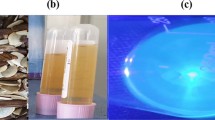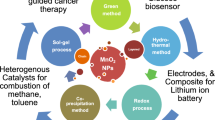Abstract
Carboxylated polyethersulfone (PES-COOH) was doped with various concentrations of ZnYCdO hybrid metal oxides on the surface of the polymer matrix to produce PES-COOH-ZnYCdO nanocomposites as a thin film. PES-COOH was fabricated by two-steps process: acetylating reaction followed by oxidation reaction, and its structure was investigated using proton nuclear magnetic resonance (1H-NMR) and Fourier-transform infrared (FT-IR) spectroscopy. Then, the fabricated PES-COOH-ZnYCdO nanocomposites (NCs) were characterized using common characterization techniques which include: scanning electron microscope (SEM), X-ray powder diffraction (XRD), FT-IR, thermal analysis, SEM with energy dispersive X-Ray (EDX) spectroscopy and transmission electron microscopy (TEM). FT-IR and XRD analysis confirmed the interactions between carboxylate ions present on the polymer surface metric and the metals that were present as ZnYCdO nanoparticles. Based on values calculated from FT-IR spectra of the PES-COOH-ZnYCdO NCs, the metals and carboxylate ions formed bindentate complexes. Also, the signal peaks of the XRD for ZnYCdO were shifted to a lower degree which also confirmed the interactions between the nanoparticles and PES-COOH. A selective Cd2+ metal ion sensor was fabricated by coating of a glassy carbon electrode (GCE) with the slurry of PES-COOH-ZnYCdO NCs polymers. The NCs assembled film onto GCE was implemented to successive detection of Cd2+ metal ion in phosphate buffer medium. To evaluate the sensor analytical performances, a calibration curve has been plotted from current versus concentration of electrolyte (Cd2+ ion). It is found linear (r2 = 0.9939) over linear dynamic range (LDR) of 0.1 nM~0.1 mM concentration of Cd2+ ion by electrochemical approach. The sensitivity and detection limit (DL) are 5.4589 μAμM−1 cm−2 and 17.39 ± 0.87 pM respectively were calculated from the slope of calibration plot. Therefore, the resultant Cd2+ sensor shows good sensitivity, reproducibility with high accuracy, wider dynamic range, short response time, very lower detection limit and long-term stability with similar performances.












Similar content being viewed by others
References
De Vries, W., Römkens, P. F., Schütze, G. (2007). Critical soil concentrations of cadmium, lead, and mercury in view of health effects on humans and animals. In Reviews of Environmental Contamination and Toxicology (pp. 91–130). Springer New York
Yang LL, Liu XM, Liu K, Liu H, Zhao FY, Ruan WJ, Bu XH (2014) A polypyridyl-pyrene based off-on Cd2+ fluorescent sensor for aqueous phase analysis and living cell imaging. Talanta 128:278–283
Hao JN, Yan B (2015) A water-stable lanthanide-functionalized MOF as a highly selective and sensitive fluorescent probe for Cd2+. Chem Commun 51(36):7737–7740
Miao Q, Wu Z, Hai Z, Tao C, Yuan Q, Gong Y, Liang G (2015) Bipyridine hydrogel for selective and visible detection and absorption of cd 2+. Nanoscale 7(6):2797–2804
Peng X, Du J, Fan J, Wang J, Wu Y, Zhao J, Xu T (2007) A selective fluorescent sensor for imaging Cd2+ in living cells. J Am Chem Soc 129(6):1500–1501
Kar C, Samanta S, Goswami S, Ramesh A, Das G (2015) A single probe to sense Al (III) colorimetrically and cd (II) by turn-on fluorescence in physiological conditions and live cells, corroborated by X-ray crystallographic and theoretical studies. Dalton Trans 44(9):4123–4132
Xu XY, Yan B (2016) Eu (III) functionalized Zr-based metal-organic framework as excellent fluorescent probe for Cd2+ detection in aqueous environment. Sensors Actuators B Chem 222:347–353
Luo Y, Tang D, Zhu W, Xu Y, Qian X (2015) Reactive fluorescent dye functionalized cotton fabric as a “magic cloth” for selective sensing and reversible separation of Cd2+ in water. J Mater Chem C 3(33):8485–8489
Agency for Toxic Substances and Disease Registry, 4770 Buford. Hwy NE, Atlanta, GA 30341
Lin ML, Jiang SJ (2013) Determination of as, cd, hg and Pb in herbs using slurry sampling electrothermal vaporisation inductively coupled plasma mass spectrometry. Food Chem 141(3):2158–2162
Ali A, Shen H, Yin X (1998) Simultaneous determination of trace amounts of nickel, copper and mercury by liquid chromatography coupled with flow-injection on-line derivatization and preconcentration. Anal Chim Acta 369(3):215–223
Koduru JR, Lee KD (2014) Evaluation of thiosemicarbazone derivative as chelating agent for the simultaneous removal and trace determination of cd (II) and Pb (II) in food and water samples. Food Chem 150(1–8):1–8
Afkhami A, Soltani-Felehgari F, Madrakian T, Ghaedi H, Rezaeivala M (2013) Fabrication and application of a new modified electrochemical sensor using nano-silica and a newly synthesized Schiff base for simultaneous determination of Cd2+, Cu2+ and Hg2+ ions in water and some foodstuff samples. Anal Chim Acta 771:21–30
Rahman MM, Hussein MA, Alamry KA, Al-Shehry FM, Asiri AM (2018) Polyaniline/graphene/carbon nanotubes nanocomposites for sensing environmentally hazardous 4-aminophenol. Nano-Struct & Nano-Obj 15:63–74
Rahman MM, Hussein MA, Abdel Salam M, Asiri AM (2017) Fabrication of an L-glutathione sensor based on PEG-conjugated functionalized CNT nanocomposites: a real sample analysis. New J Chem 41:10761–10772
Awual MR, Alharthi NH, Hasan MM, Karim MR, Islam A, Znad H, Khaleque MA (2017) Inorganic-organic based novel nano-conjugate material for effective cobalt (II) ions capturing from wastewater. Chem Eng J 324:130–139
Bagheri, S., Iraj S. A., Amin T. Y., Sharifah B. A. (2016). Nanocomposites in electrochemical sensors. CRC Press Book, Taylor & Francis eBooks, London
Shrivastava S, Jadon N, Jain R (2016) Next-generation polymer nanocomposite-based electrochemical sensors and biosensors: a review. TrAC Trends Anal Chem 82:55–67
Abu-Thabit N, Umar Y, Ratemi E, Ahmad A, Ahmad Abuilaiwi F (2016) A flexible optical pH sensor based on polysulfone membranes coated with pH-responsive polyaniline nanofibers. Sensors 16(7):986
Wang D, Zou W, Li L, Wei Q, Sun S, Zhao C (2011) Preparation and characterization of functional carboxylic polyethersulfone membrane. J Membr Sci 374(1):93–101
Ying L, Yu WH, Kang ET, Neoh KG (2004) Functional and surface-active membranes from poly (vinylidene fluoride)-graft-poly (acrylic acid) prepared via RAFT-mediated graft copolymerization. Langmuir 20(14):6032–6040
Kim YJ, Kang IK, Huh MW, Yoon SC (2000) Surface characterization and in vitro blood compatibility of poly (ethylene terephthalate) immobilized with insulin and/or heparin using plasma glow discharge. Biomaterials 21(2):121–130
Deng B, Yang X, Xie L, Li J, Hou Z, Yao S, Liang G, Sheng K, Huang Q (2009) Microfiltration membranes with pH dependent property prepared from poly (methacrylic acid) grafted polyethersulfone powder. J Membr Sci 330(1–2):363–368
Deng B, Li J, Hou Z, Yao S, Shi L, Liang G, Sheng K (2008) Microfiltration membranes prepared from polyethersulfone powder grafted with acrylic acid by simultaneous irradiation and their pH dependence. Radiat Phys Chem 77(7):898–906
Fu SS, Ning JP, Liao XH, Fu X, Yang ZB (2015) Preparation and characterization of a thrombin inhibitor grafted polyethersulfone blending membrane with improved antithrombotic property. RSC Adv 5(116):95710–95716
Haider MS, Shao GN, Imran SM, Park SS, Abbas N, Tahir MS, Hussain M, Bae W, Kim HT (2016) Aminated polyethersulfone-silver nanoparticles (AgNPs-APES) composite membranes with controlled silver ion release for antibacterial and water treatment applications. Mater Sci Eng C 62:732–745
Qu P, Tang H, Gao Y, Zhang L, Wang S (2010) Polyethersulfone composite membrane blended with cellulose fibrils. BioResources 5(4):2323–2336
Nakamoto, K. (1977). Infrared and Raman spectra of inorganic and coordination compounds (pp. 231–233). Wiley
Otero V, Sanches D, Montagner C, Vilarigues M, Carlyle L, Lopes JA, Melo MJ (2014) Characterisation of metal carboxylates by Raman and infrared spectroscopy in works of art. J Raman Spectrosc 45(11–12):1197–1206
Vadukumpully S, Paul J, Mahanta N, Valiyaveettil S (2011) Flexible conductive graphene/poly (vinyl chloride) composite thin films with high mechanical strength and thermal stability. Carbon 49(1):198–205
Yu L, Zhang Y, Zhang B, Liu J, Zhang H, Song C (2013) Preparation and characterization of HPEI-GO/PES ultrafiltration membrane with antifouling and antibacterial properties. J Membr Sci 447:452–462
Hussain MM, Asiri AM, Arshad MN, Rahman MM (2018) Fabrication of a Ga3+ sensor probe based on methoxybenzylidenebenzenesulfonohydrazide (MBBSH) by an electrochemical approach. New J Chem 42(2):1169–1180
Hussain MM, Rahman MM, Arshad MN, Asiri AM (2017) Electrochemical detection of Ni2+ ions using synthesized (E)-N’-Chlorobenzylidene-4-methylbenzenesulfonohydrazide derivatives modified with a Nafion matrix. ChemistrySelect 2(24):7455–7464
Ahmad I, Arshad MN, Rahman MM, Asiri AM, Sheikh TA, Aqlan FM (2017) Crystal structure of N′-[(E)-(2-hydroxynaphthalen-1-yl) methylidene] benzenesulfonohydrazide (HNMBSH) and its application as Pb2+ ion sensor by its fabrication onto glassy carbon electrode. Inorg Chim Acta 467:297–306
Sheikh TA, Arshad MN, Rahman MM, Asiri AM, Marwani HM, Awual MR, Bawazir WA (2017) Trace electrochemical detection of Ni 2+ ions with bidentate N, N′-(ethane-1, 2-diyl) bis (3, 4-dimethoxybenzenesulfonamide)[EDBDMBS] as a chelating agent. Inorg Chim Acta 464:157–166
Ren S, Li C, Zhao X, Wu Z, Wang S, Sun G, Xin Q, Yang X (2005) Surface modification of sulfonated poly (ether ether ketone) membranes using Nafion solution for direct methanol fuel cells. J Membr Sci 247(1–2):59–63
Wang Z, Liu G, Zhang L, Wang H (2013) Electrochemical detection of trace cadmium in soil using a Nafion/stannum film-modified molecular wire carbon paste electrodes. Ionics 19(11):1687–1693
Arshad MN, Sheikh TA, Rahman MM, Asiri AM, Marwani HM, Awual MR (2017) Fabrication of cadmium ionic sensor based on (E)-4-methyl-N′-(1-(pyridin-2-yl) ethylidene) benzenesulfonohydrazide (MPEBSH) by electrochemical approach. J Organomet Chem 827:49–55
Author information
Authors and Affiliations
Corresponding authors
Ethics declarations
Conflict of interest
The authors declare that they have no conflict of interest.
Electronic supplementary material
ESM 1
(DOCX 446 kb)
Rights and permissions
About this article
Cite this article
Hussein, M.A., Alam, M.M., Alenazi, N.A. et al. Nanocomposite based functionalized Polyethersulfone and conjugated ternary ZnYCdO nanomaterials for the fabrication of selective Cd2+ sensor probe. J Polym Res 25, 262 (2018). https://doi.org/10.1007/s10965-018-1643-y
Received:
Accepted:
Published:
DOI: https://doi.org/10.1007/s10965-018-1643-y




